3D Printer Changes Everything
New York's Caldwell Manufacturing has integrated 3D printing into everything from R&D to internal tools to production parts. By using 3D printers from Markforged, the hardware manufacturing company is producing parts -- that would previously cost anywhere between $300-$5,000 if made using traditional methods -- now for just $30.
Caldwell Manufacturing is a global window and door hardware manufacturer based in upstate New York. "We're an integrated supply partner," says Caldwell Manufacturing CEO, Eric Mertz. "The springs that hold a window or door open, the hardware, the locks, the latches, all the mechanical hardware that makes a window or door operate, that's what we're focused on."
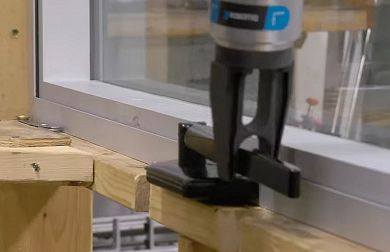
Caldwell Manufacturing produces the mechanical hardware for doors and windows.
The company was founded in 1888 and spent the first of its years as a hardware manufacturing company. In the 1920's, the company diversified into building-related products. Caldwell now ships to thousands of customers in 70 different countries, and has factories in the US, UK, India, and Mexico. The team is responsible for everything from design ideation to final product -- they develop and commercialize Caldwell's components while simultaneously creating injection molds, springs, and more.
The Challenge
For any piece of window or door hardware they make, the team at Caldwell also needs to make holding fixtures, assembly fixtures, and error-proofing fixtures -- which were all designed in-house and cut from steel through a third-party supplier. The internal tooling often took up to eight weeks to design and develop, and certain components had to be sourced from overseas, which led to product development cycles of anywhere between 6-12 months.
A single job would require people to look for outside quotes or internal tool room quotes, and any changes to internal tooling were time consuming and expensive, so improvements needed to be significant to justify.
VIDEO: Watch how Caldwell Manufacturing has completely adopted additive manufacturing throughout the organization.
"Sometimes businesses just end up layered with bureaucracy," says Mertz. "And one of the reasons people leave their jobs is because they don't feel connected. They don't feel they've got the authority and the resources to do their job."
In the company's strategic planning meeting in 2010, the executives looked at what kind of technologies were going to be disruptive, and unanimously agreed that 3D printing would be the key to their success.
In 2014, Caldwell purchased its first FDM plastic 3D printer. "3D printing was a technology that we were watching for a couple of years," says Mertz. "And as its price points come down, it's one of those things that encouraged the buying decision." Initially, the printer was brought in for rapid prototyping, but the team quickly realized that the printer was only able to help them evaluate form and fit, but not function.
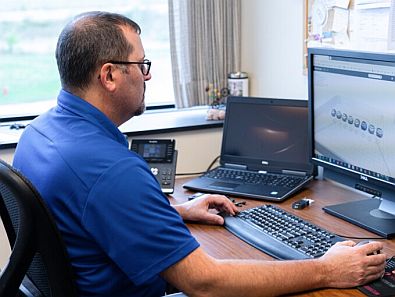
Product Engineering Manager Rick deNormand using Markforged Eiger software.
"We wanted to put the control within our own hands to allow for quicker iterations on our product development," says Rick deNormand, Product Engineering Manager at Caldwell.
Many of the parts Caldwell Manufacturing needed were made out of metal, and the team found plastic 3D printer filament was not adequate to use when testing the strength of their parts.
"The plastic 3D printer that we onboarded really resolved much of our external prototyping needs for plastic parts,"' says deNormand. "But what we really needed was to explore and to introduce metal 3D printing as well."
Selective laser melting (SLM) metal 3D printers didn't fit the need of the organization, as the use of powder was too difficult to handle and the cost to bring it in was too high. The team set to work looking for the optimal solution: an affordable filament-based metal 3D printer that could easily be used within the facility.
The Solution
In 2017, Caldwell Manufacturing started to look for other 3D printers. Members of the team attended a manufacturing trade show and came across the Markforged platform. After hearing about the company's track record of producing best-in-class printers, they decided to purchase a Metal X system -- capable of printing in 17-4 PH Stainless Steel, Inconel, and Copper. "We selected Markforged based on the company's history of 3D printing and basically our level of confidence with them," says deNormand.
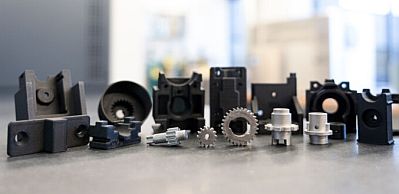
3D printed metal and carbon fiber components for R&D testing.
Caldwell also purchased a Mark Two 3D printer alongside the Metal X system, which can print in continuous carbon fiber as well as other reinforcing materials. The team initially brought in this printer for R&D purposes but has since started to use it for internal tooling.
The Metal X system, on the other hand, has enabled Caldwell's engineers and designers to print prototype metal parts that would traditionally be cast out of zinc or stainless steel. "The metal 3d printer enabled us to prototype those parts in which we weren't in a position to be able to do before," says deNormand.
The same parts that would previously cost anywhere between $300-$5,000 if made using traditional methods now cost $30 and take three days to produce instead of up to eight weeks. The team is now able to test the parts, share them with customers for evaluation, and collect feedback to help in the design of their products. "It changes the design cycle to more of a fail-fast mode," says Mertz. "It really changes your mindset about how we design, the way we test, the way we validate. It changes the way we put products into production. It's changed everything."
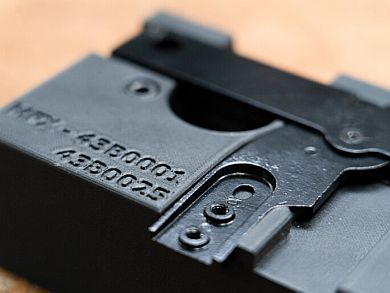
An assembly fixture printed in Markforged continuous carbon fiber.
Caldwell has well and truly integrated 3D printing into everything, from R&D, robotic parts for testing, assembly fixtures, tooling, all the way to post-processed parts for customers. The team 3D prints tooling for the shop floor, and the assemblers can provide feedback and suggestions for improvement.
"If an assembler feels like there's a change that needs to be made, I have no hesitation making a change," says Manufacturing Engineer Phillip Cole. "We quickly make a design change, send it to the printer, and swap it out." What used to take 6-12 months to do now takes the team 6-12 days, thanks to the carbon fiber 3D printer.
Overall, the addition of these two Markforged 3D printers has removed bureaucracy and added autonomy, according to Mertz. "It's given them the tools they need to put their thoughts into parts," he says. "And ultimately, I think it's bigger than that. I think that those things create more engagement from our employees. It's part of our culture now."
The Future
Caldwell Manufacturing recognizes that there's still a long way to go.
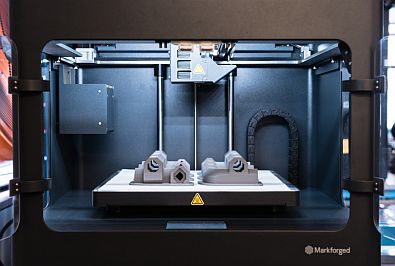
Markforged Metal X 3D Printer
"I think we're just scratching the surface for what the technology is going to do, evolve into, and how it'll change low-volume production for the future," says Mertz. The company expects that in five years, each of its manufacturing plants will have 3D printers for small-volume, low-run, custom-production parts.
As of now, they have installed Markforged printers in two of its four North American manufacturing facilities and have roughly 18 low-volume end-use components being produced using these printers. By the end of the year, the team plans to add printers to its other two North American locations.
"We continue to realize the benefits of owning this technology and are genuinely excited about its future," says deNormand. "Our 3D printers have become the most utilized equipment in our R&D model shop. Our new products and assembly processes are more robust, and we are able to introduce them to the market faster."
Want more information? Click below.
Rate this article
View our terms of use and privacy policy ::m::